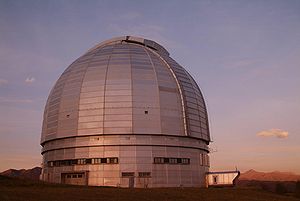BTA-6
 |
|
| Organisation | SAO RAS |
|---|---|
| Location(s) | near Mount Pastukhov in the Caucasus Mountains, Russia |
| Coordinates | 43°38′48.57″N 41°26′25.61″E / 43.6468250°N 41.4404472°ECoordinates: 43°38′48.57″N 41°26′25.61″E / 43.6468250°N 41.4404472°E |
| Altitude | 2,070 m (6,790 ft) |
| Wavelength | 0.3–10 μm |
| Built | First light 1975 |
| Telescope style | Ritchey-Chrétien |
| Diameter | 605 cm |
| Collecting area | 26 m² |
| Focal length | f/4 (24 m) |
| Mounting | alt-azimuth fully steerable primary |
| Website | Special Astrophysical Observatory |
|
|
|
|
[]
|
|
The BTA-6 (Russian: Большой Телескоп Альт-азимутальный, Bolshoi Teleskop Alt-azimutalnyi, Large Altazimuth Telescope) is a 6-metre (20 ft) aperture optical telescope at the Special Astrophysical Observatory located in the Zelenchuksky District on the north side of the Caucasus Mountains in southern Russia.
The BTA-6 achieved first light in late 1975, making it the largest telescope in the world until 1990, when it was surpassed by the partially constructed Keck 1. It pioneered the technique, now standard in large astronomical telescopes, of using an altazimuth mount with a computer-controlled derotator.
For a variety of reasons, BTA-6 was never able to operate near its theoretical limits. Early problems with poorly fabricated mirror glass were addressed in 1978, fixing the most serious issue. But due to its location down-wind of numerous large mountain peaks, astronomical seeing is rarely good. The telescope also suffers from serious thermal expansion problems due to the large thermal mass of the mirror, and the dome as a whole which is much larger than necessary. Upgrades have taken place throughout the system's history and are ongoing to this day.
For many years the primary world-class observatory in the Soviet Union was the Pulkovo Observatory outside Saint Petersburg, originally built in 1839. Like many observatories of its era, it was primarily dedicated to timekeeping, weather, navigation and similar practical tasks, with a secondary role for scientific research. Around its 50th anniversary a new 76 cm telescope, then the world's largest, was installed for deep space observation. Further upgrades were limited due to a variety of factors, while a number of much larger instruments were built around the world over the next few decades.
...
Wikipedia
